It looks like you're using an Ad Blocker.
Please white-list or disable AboveTopSecret.com in your ad-blocking tool.
Thank you.
Some features of ATS will be disabled while you continue to use an ad-blocker.
23
share:
*I did a search on ATS prior to putting this thread together. I didn’t see anything posted though the search tool is notoriously terrible. If
someone has already posted about this, apologies.*
Hi all! I haven't posted in a while but I thought this would be a fun little topic to discuss. I came across an article a couple weeks ago talking about modern day treasure hunts. One stood out to me so I began finding some more information and it turned into a major time suck although fascinating.
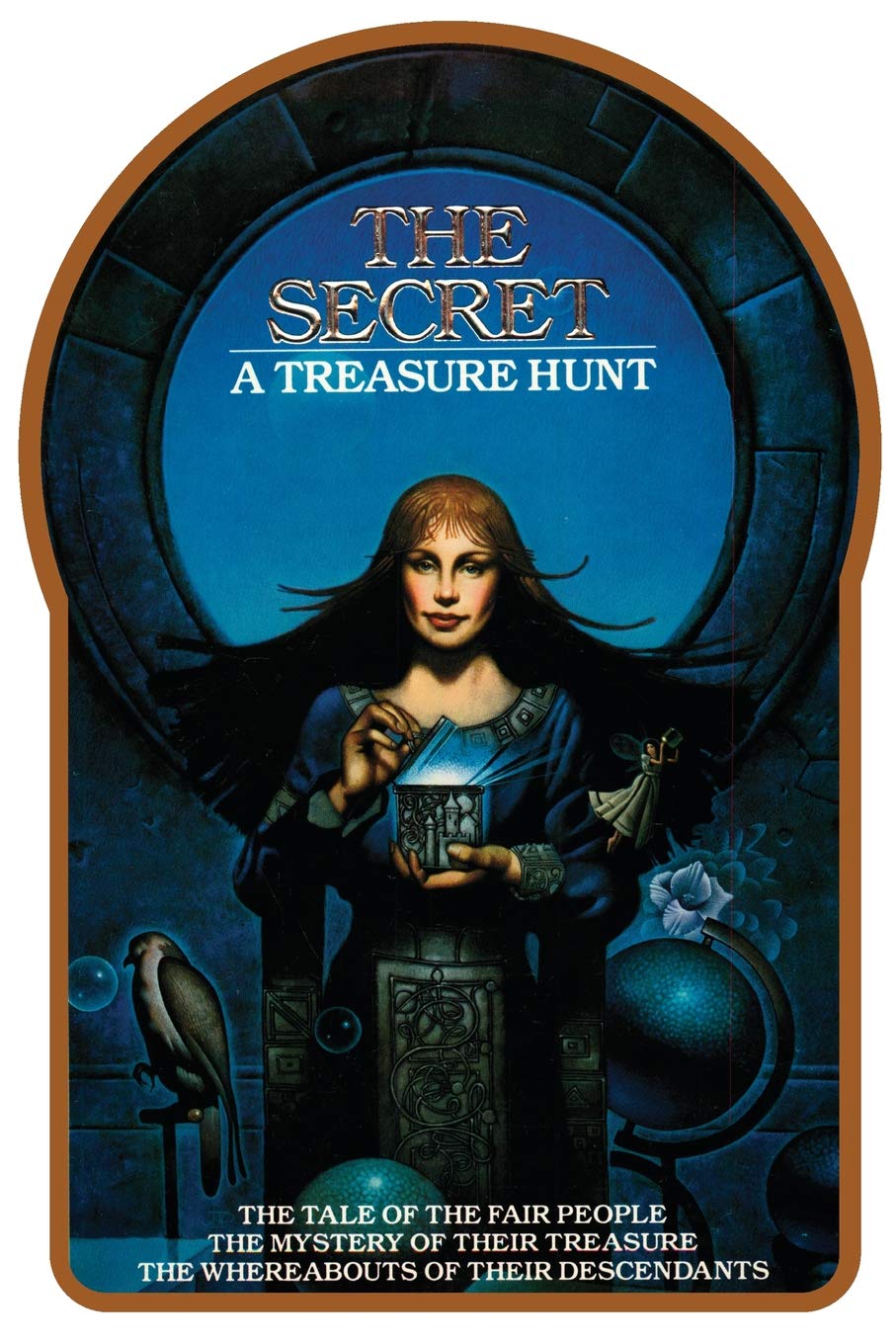
In 1982, Byron Preiss published The Secret, a puzzle book that combined 12 short verses and 12 elaborate fantasy paintings by John Jude Palencar. Readers were expected to pair each painting with a verse in a way that would provide clues to finding one of 12 plexiglass boxes buried in various parks around North America. Each box contained a ceramic key that could be redeemed for a jewel worth $1,000.
One of the ceramic boxes was found in Chicago in 1983. Another was found in Cleveland in 2004. The remaining 10 boxes have never been found.
Unfortunately, Preiss died in a car accident in 2005. However, the publishing company is on record that it will honor and of the remaining casks/keys if found.
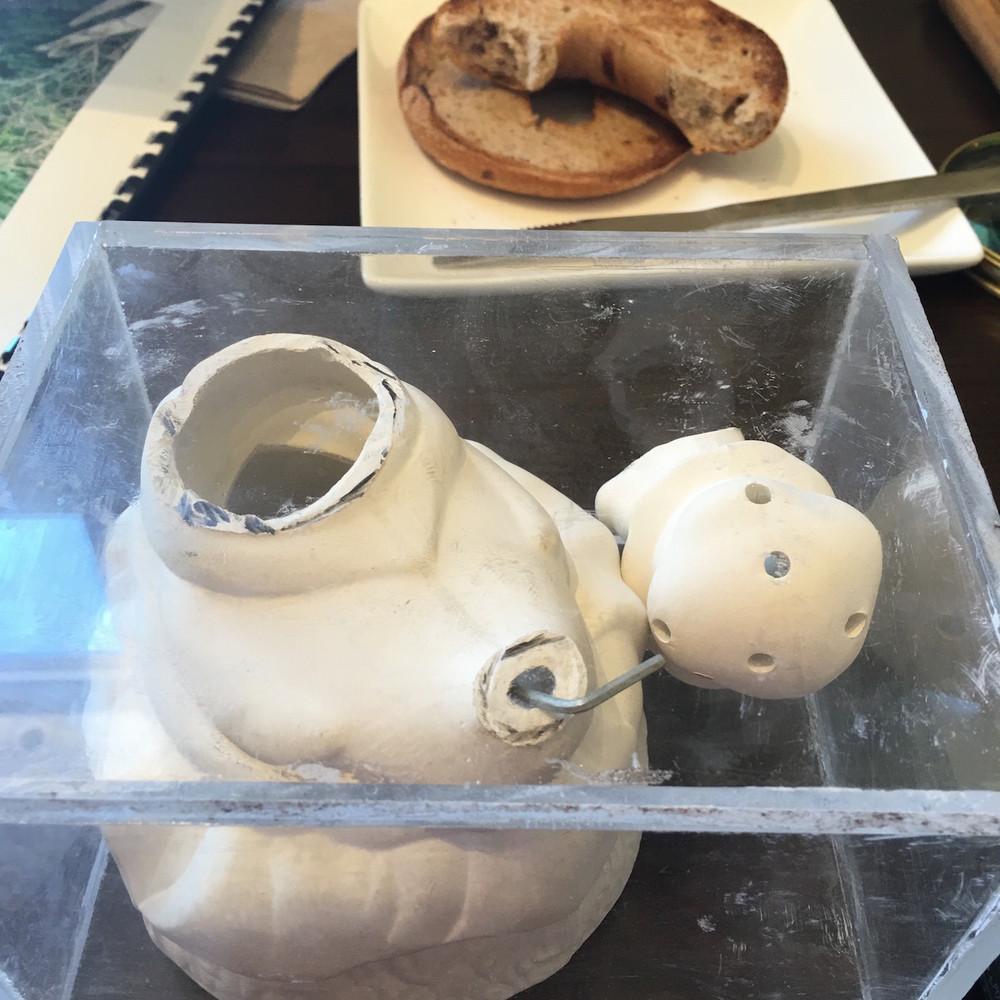
THE RULES
"The jewels collectively are worth over ten thousand dollars. The treasure casques themselves are of incalculable value, never having been owned by man or woman."
"Every treasure casque is buried underground, at a depth of no more than three to three and one-half feet. The casques are protected by lustrous transparent boxes and are sealed."
"The following places do not hold any treasure:
(a) any life-threatening location, such as a dangerous highway embankment, a contaminated area or active railway track
(b) any cemetery
(c) any public or private flower bed
(d) any property owned by the contributors to the book, their families or friends."
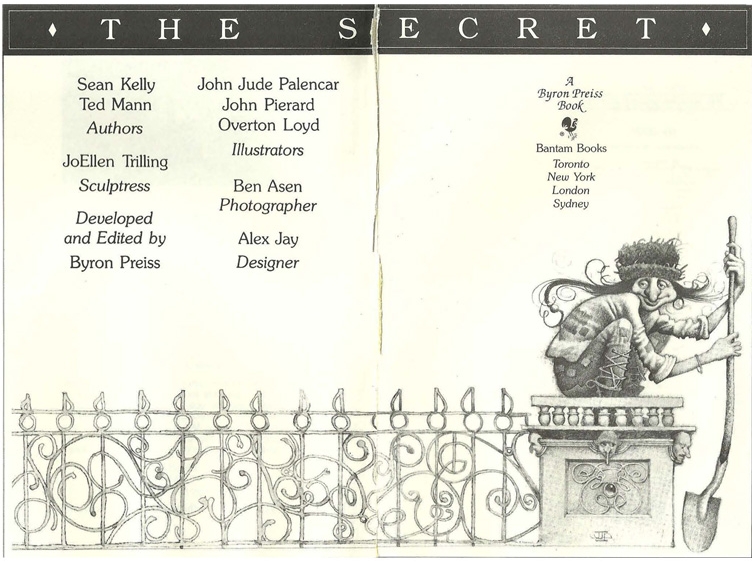
A few other bits of wisdom about the treasure spots are well worth keeping in mind:
Preiss was obviously a responsible citizen and he wouldn't have wanted his treasure hunt to cause any harm or do any damage. Your solution shouldn't require you to tear up a lawn or disturb a natural area. The casques are only going to be in places that have already been disturbed by humans and where further digging wouldn't be a problem.
In every case that we know of, the burial site is beside some distinctive, man-made feature that is represented in the image or verse. (See the Solutions page for more info on the "Aha! icon.") The presence of the artificial feature within a few feet means that the casque can't be out in an open area or in some pristine natural preserve. There has to be a distinctive object (made by humans) very close to the burial spot.
Hi all! I haven't posted in a while but I thought this would be a fun little topic to discuss. I came across an article a couple weeks ago talking about modern day treasure hunts. One stood out to me so I began finding some more information and it turned into a major time suck although fascinating.

In 1982, Byron Preiss published The Secret, a puzzle book that combined 12 short verses and 12 elaborate fantasy paintings by John Jude Palencar. Readers were expected to pair each painting with a verse in a way that would provide clues to finding one of 12 plexiglass boxes buried in various parks around North America. Each box contained a ceramic key that could be redeemed for a jewel worth $1,000.
One of the ceramic boxes was found in Chicago in 1983. Another was found in Cleveland in 2004. The remaining 10 boxes have never been found.
Unfortunately, Preiss died in a car accident in 2005. However, the publishing company is on record that it will honor and of the remaining casks/keys if found.

THE RULES
"The jewels collectively are worth over ten thousand dollars. The treasure casques themselves are of incalculable value, never having been owned by man or woman."
"Every treasure casque is buried underground, at a depth of no more than three to three and one-half feet. The casques are protected by lustrous transparent boxes and are sealed."
"The following places do not hold any treasure:
(a) any life-threatening location, such as a dangerous highway embankment, a contaminated area or active railway track
(b) any cemetery
(c) any public or private flower bed
(d) any property owned by the contributors to the book, their families or friends."

A few other bits of wisdom about the treasure spots are well worth keeping in mind:
Preiss was obviously a responsible citizen and he wouldn't have wanted his treasure hunt to cause any harm or do any damage. Your solution shouldn't require you to tear up a lawn or disturb a natural area. The casques are only going to be in places that have already been disturbed by humans and where further digging wouldn't be a problem.
In every case that we know of, the burial site is beside some distinctive, man-made feature that is represented in the image or verse. (See the Solutions page for more info on the "Aha! icon.") The presence of the artificial feature within a few feet means that the casque can't be out in an open area or in some pristine natural preserve. There has to be a distinctive object (made by humans) very close to the burial spot.
Part 2
Here is a list of the 12 paintings and the city they likely represent. I did not include the verses for each because it would take up to much space. They can be found with a Google search.I’ve also included the solution for the Cleveland treasure to show some insight into how these puzzles are put together.
Image 1 - San Francisco
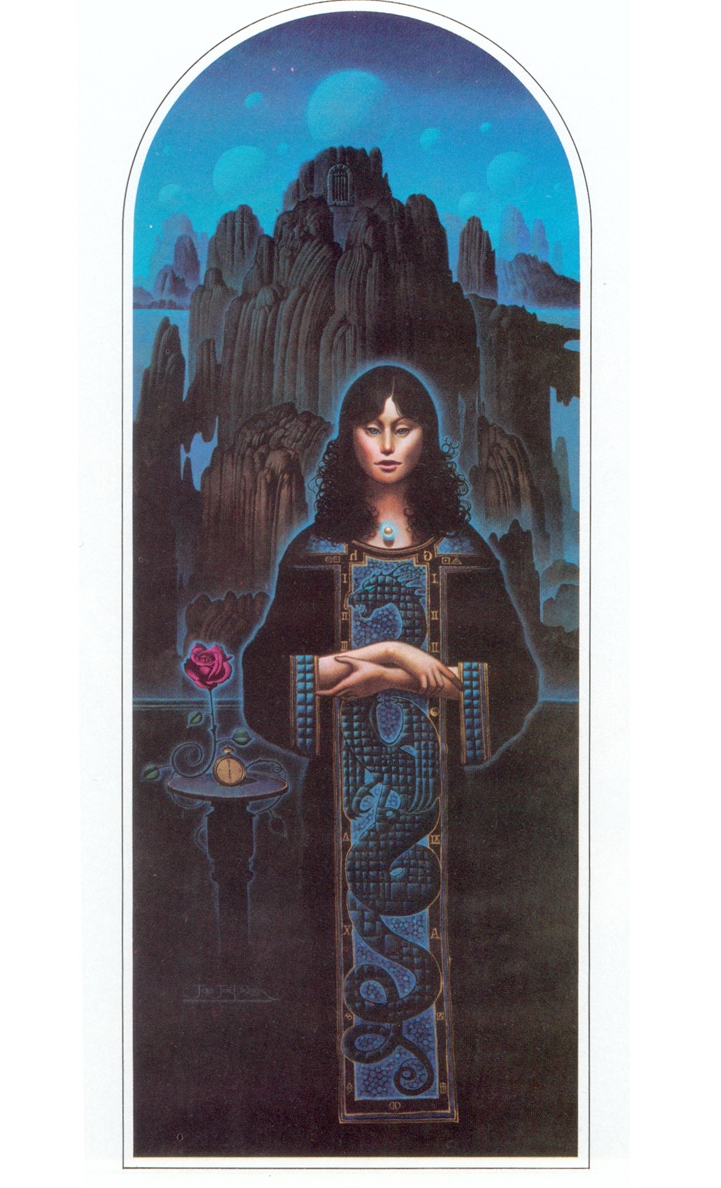
Image 2 - Charleston
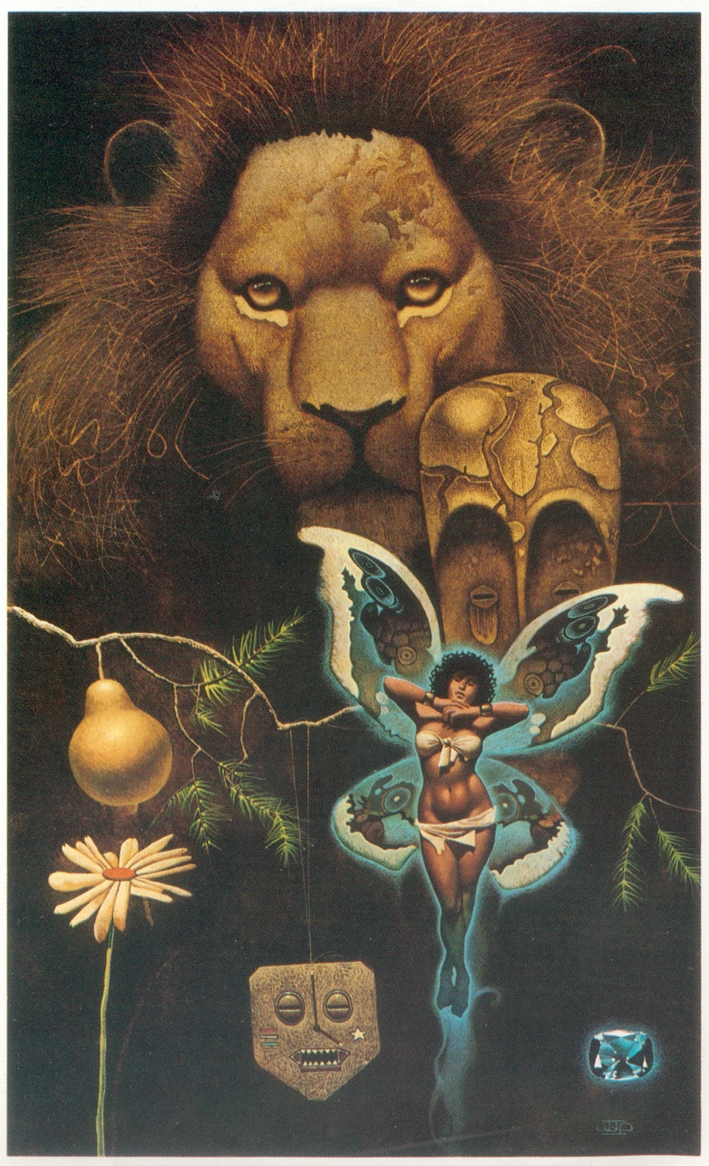
Image 3 - Roanoke Island
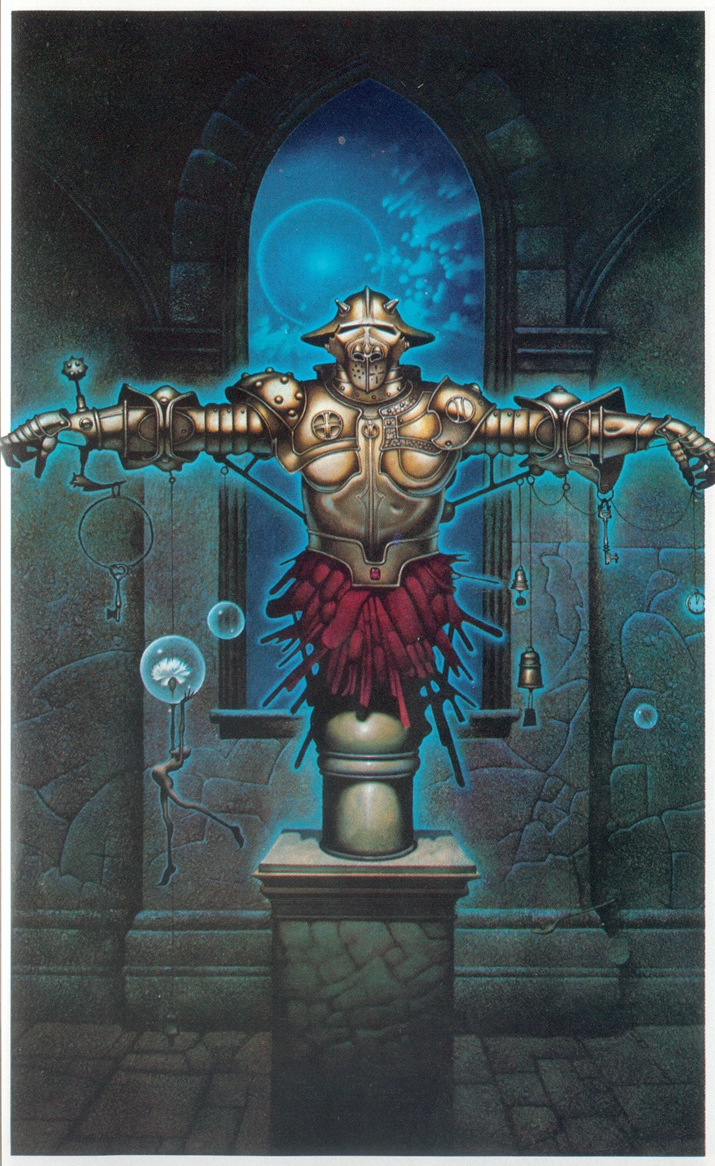
Image 4 - Cleveland
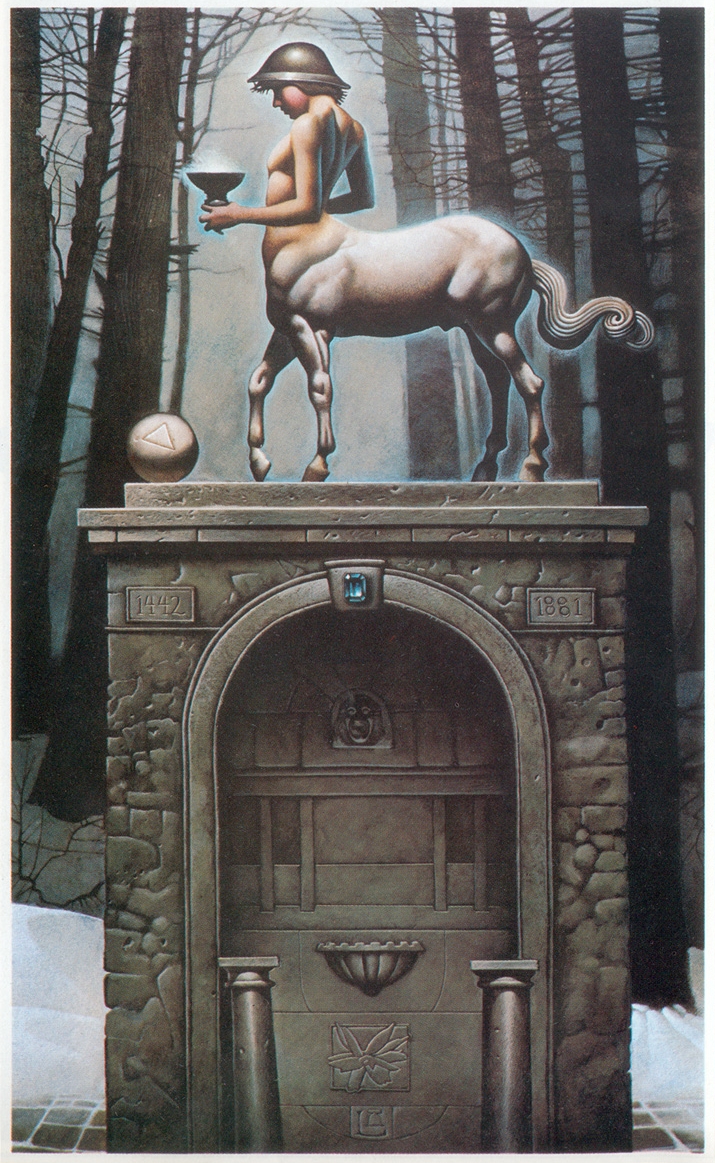
Image 5 - Chicago
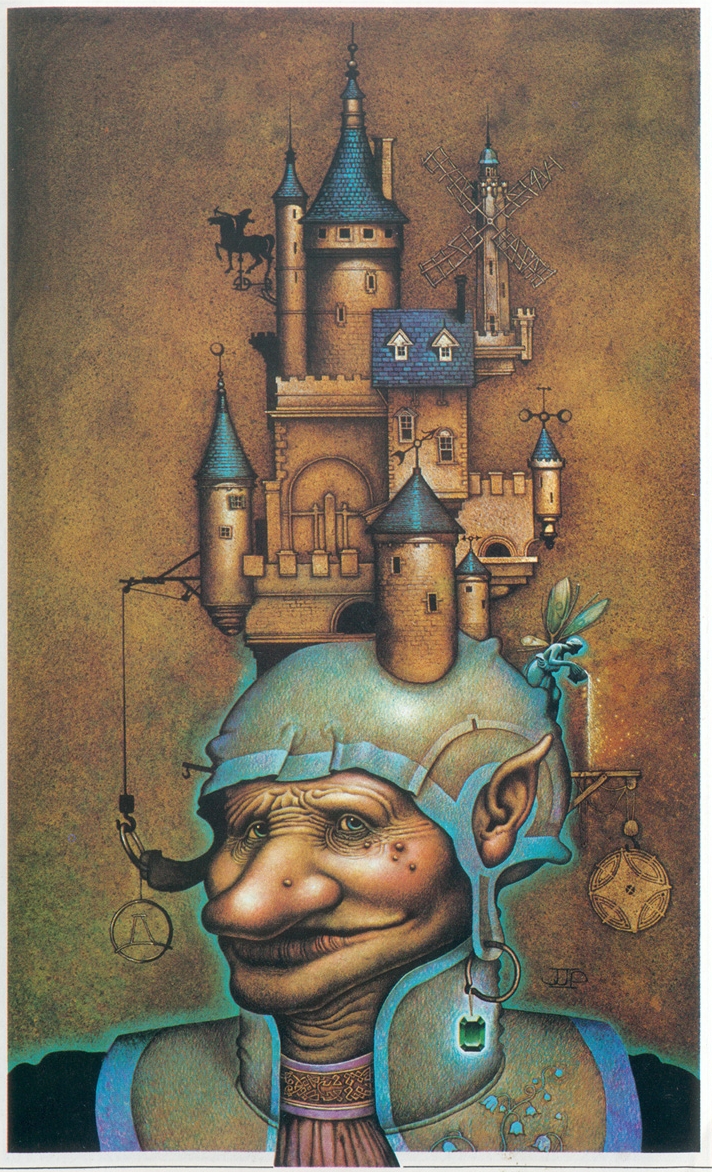
Image 6 - St. Augustine

Image 7 - New Orleans

Image 8 - Houston
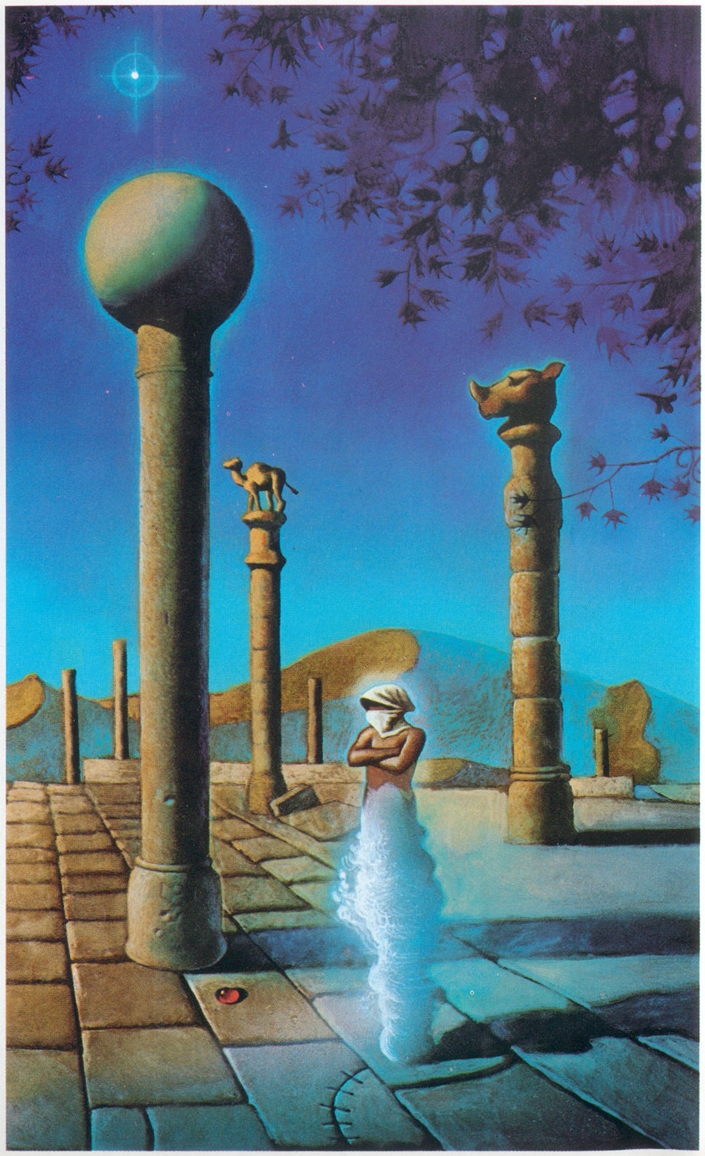
Image 9 - Montreal
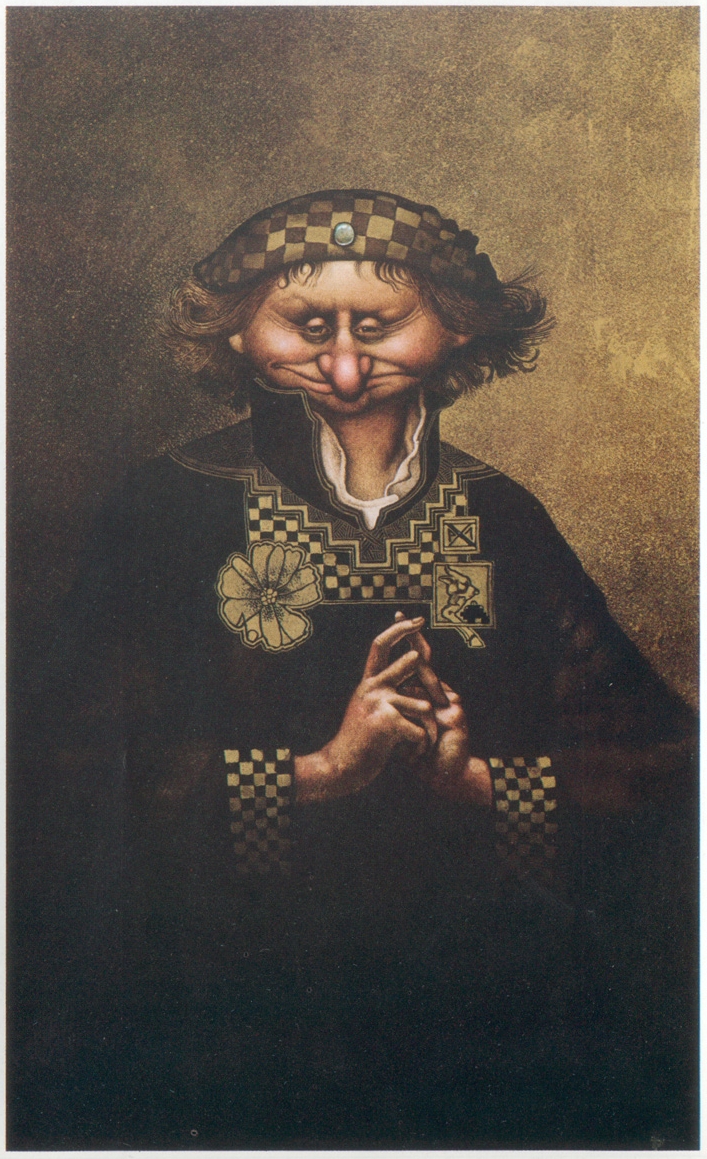
Image 10 - Milwaukee
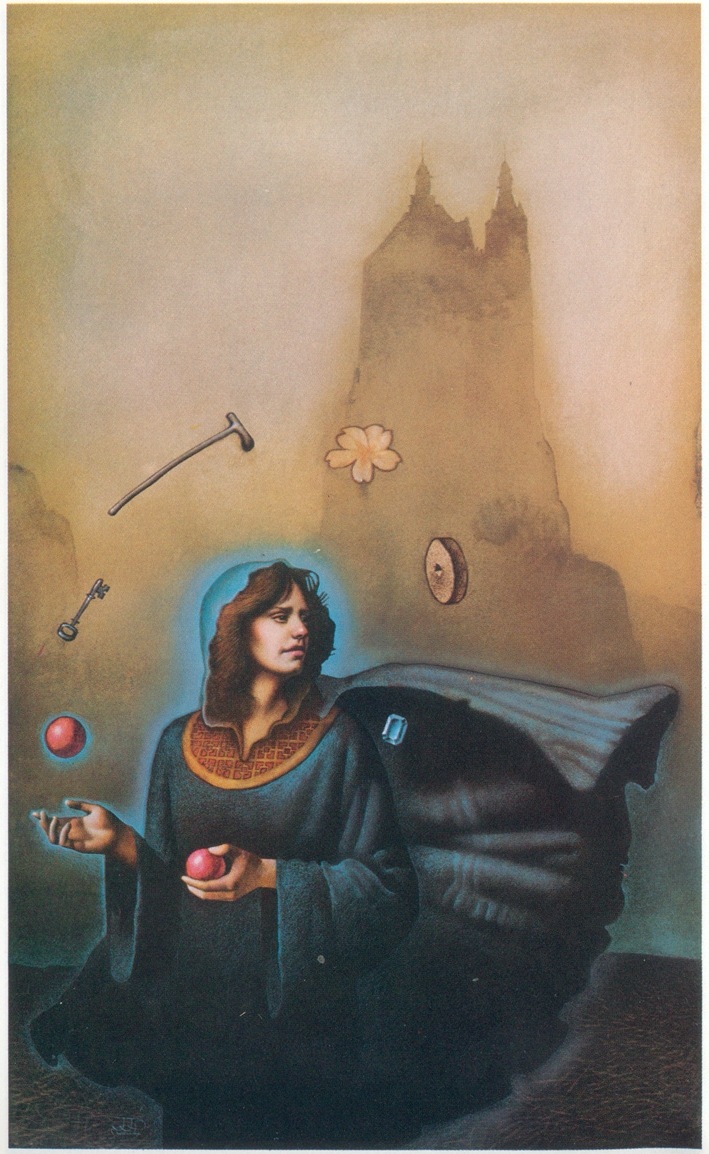
Image 11 - Boston
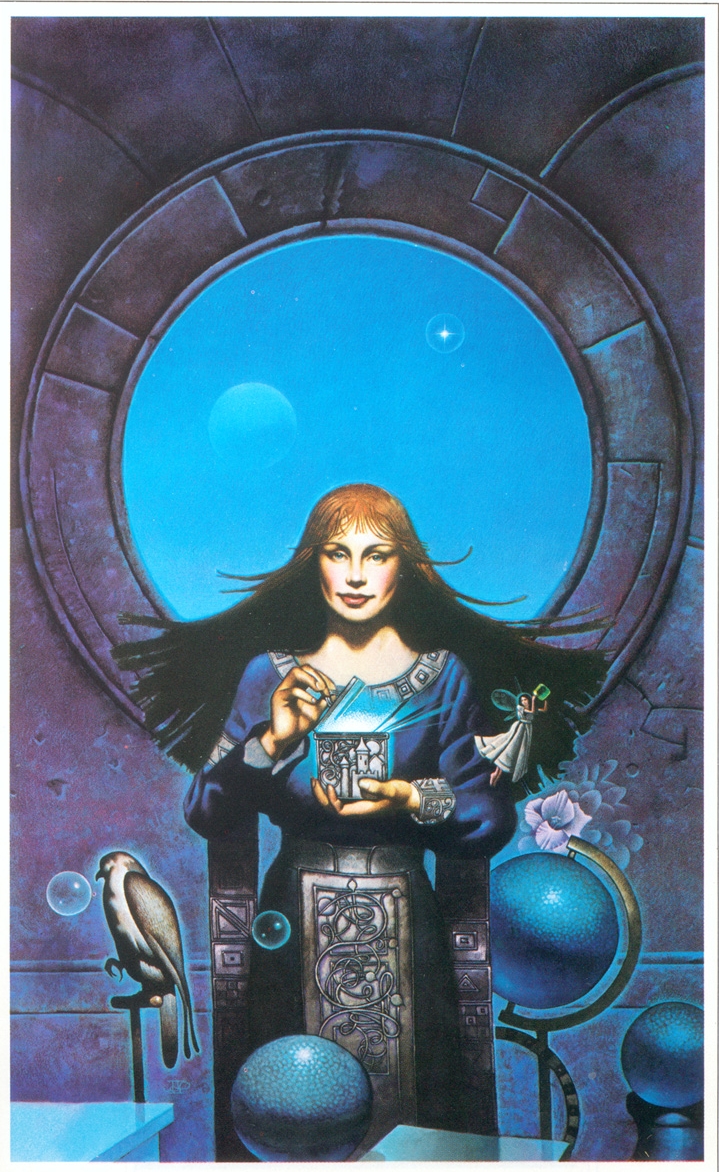
Image 12 - New York City
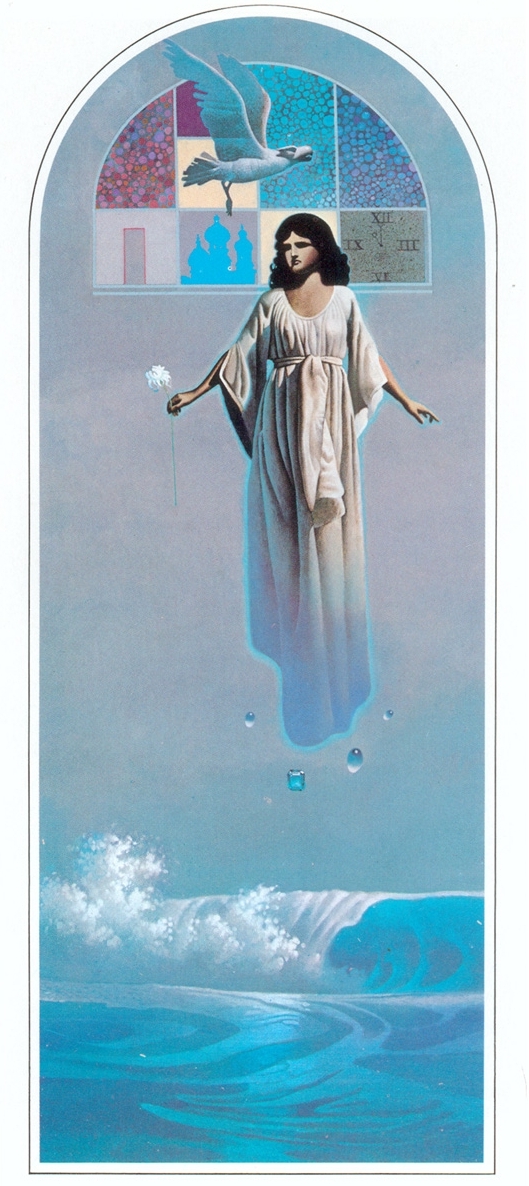
Here is a list of the 12 paintings and the city they likely represent. I did not include the verses for each because it would take up to much space. They can be found with a Google search.I’ve also included the solution for the Cleveland treasure to show some insight into how these puzzles are put together.
Image 1 - San Francisco

Image 2 - Charleston

Image 3 - Roanoke Island

Image 4 - Cleveland

Image 5 - Chicago

Image 6 - St. Augustine

Image 7 - New Orleans

Image 8 - Houston

Image 9 - Montreal

Image 10 - Milwaukee

Image 11 - Boston

Image 12 - New York City

a reply to: jtrenthacker
Oh my Goodness. I think I know where the Milwaukee one might be...............
or very close to it, I recognized it immediately.
Oh my Goodness. I think I know where the Milwaukee one might be...............
or very close to it, I recognized it immediately.
Part 3
Painting 4 Verse 4 Solution
The solution given below will present clues from the verse and the image in a way that narrows down the search area to that specific point. Bits of the original image are shown in the left column in cells with a tan background. Lines from the verse are in the same column but with a yellow background. (For more detail about any particular clue, check the page for the image or verse.)
1. The shape to the left of the monument suggests that we should be looking in Ohio, possibly near a major highway.
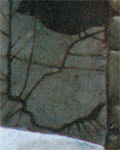
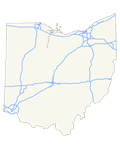
2. As discussed above these icons hint at latitude and longitude, but only of some numbers are reversed or possibly also moved out or order.
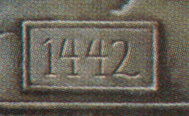
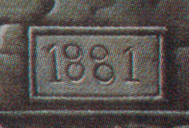
Reversing the 14 could give us a bracket of 41 & 42. The 1881 is a question mark using this technique.
Reversing the 14 and introducing a decimal could give us 41.42.
Reversing the 18 AND moving it out of order could give us 81.81.
This would get us close to Cleveland but not near the park that we know is correct.
Cleveland is of course also confirmed by the Terminal Tower image match.
3. The sphere with the triangle on it shape is a reference to Euclid "The Father of Geometry." He was of course, also Greek.
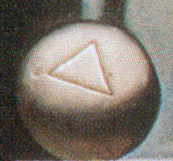
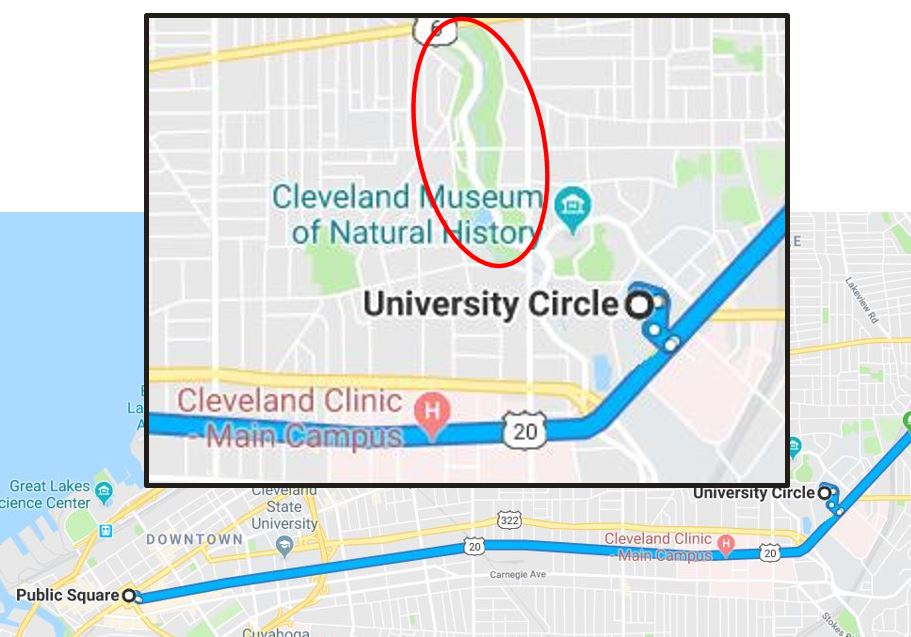
Euclid Ave (Route 20) is a major Cleveland thoroughfare that runs from downtown through East Cleveland. It runs by the lower section of Rockefeller Park which is home to the Cultural Gardens.
That area also contains Bellflower Road and the last remnant of Liberty Blvd. (See below for more info)
4. The icon of the bell and flower in close proximity may hint at Bellflower Road. However reading of lines usually flows down.
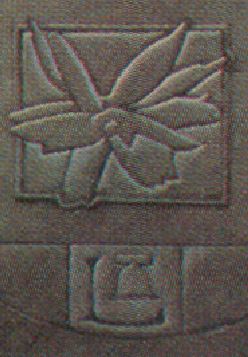
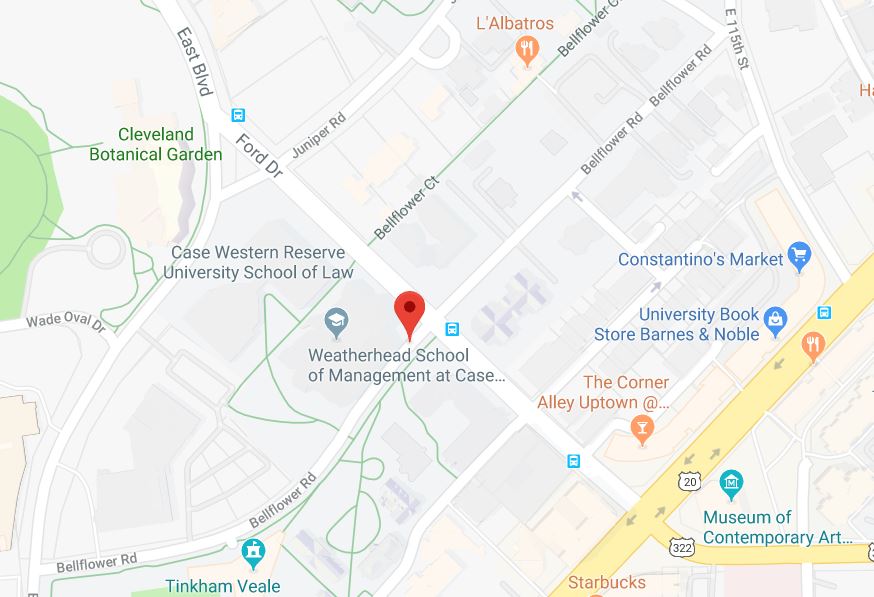
To make a Bell+Flower rebus from these icons, this would need to be another example of something that is backwards or reversed in this puzzle.
Bellflower Road is shown here in its entirely. Its length is entirely within the campus of Case Western Reserve University. There are many buildings of higher learning nearby plus a hospital, performing arts center and Science and Art museums.
With many of the arts and sciences flowing from the Greek tradition, if Preiss intended Bellflower Road to be a clue in the puzzle, this would be a likely reason why.
5. Just south and west of Bellflower road and next to the university campus is the last remaining remnant of Liberty Boulevard.

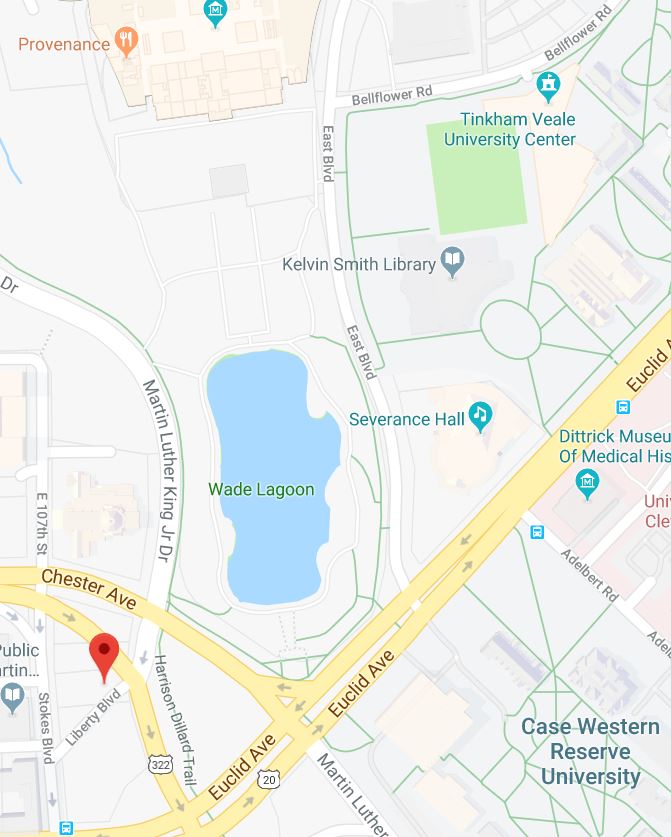
In 1981 the rest of Liberty Blvd was renamed Martin Luther King Dr. That is the road that runs up through the park and through the Cultural Gardens.
Liberty Blvd was in turn a street that was renamed in 1919. It was so named on Memorial Day 1919 to commemorate Liberty Row.
Which is definitely the main reason for this "Liberty" (bell) icon and is the clue that bring us up from Euclid Ave into Rockefeller Park and toward the Cultural Gardens.
6. Liberty Row was the name given to what was then one of the first "living memorials."
By that Memorial Day celebration hundreds of "Liberty Oaks" were planted along a nine-mile string of several connected roads running next to and through a string of parks in this section of Cleveland. At the foot of each Liberty Oak was embedded a circular bronze marker with the name of a soldier killed in the recently concluded WWI.
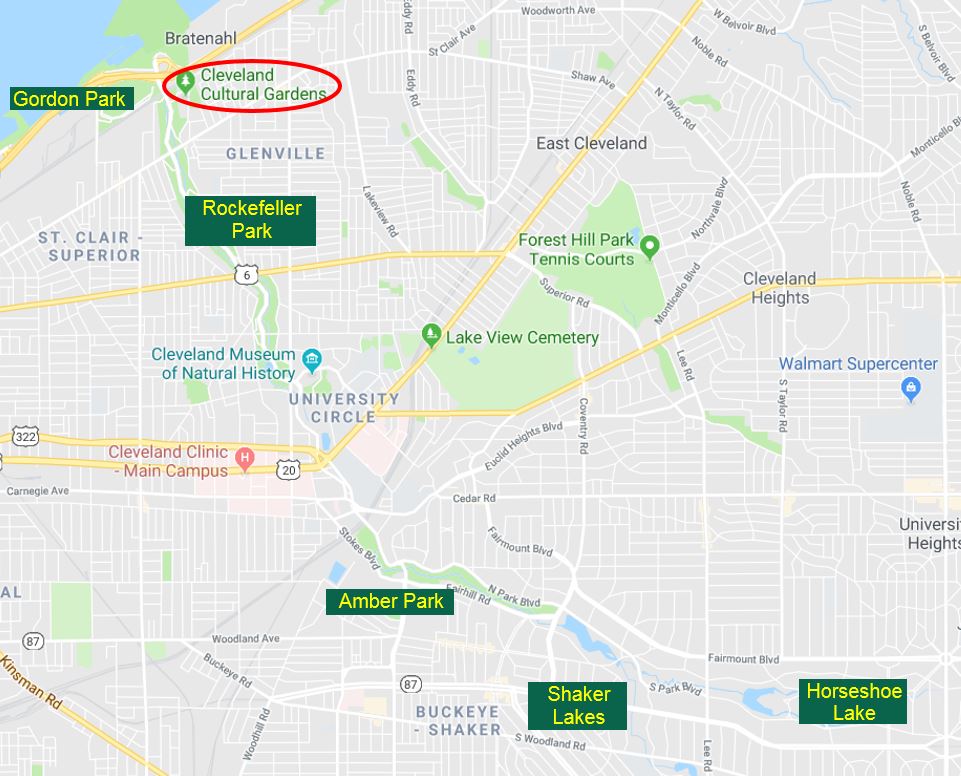
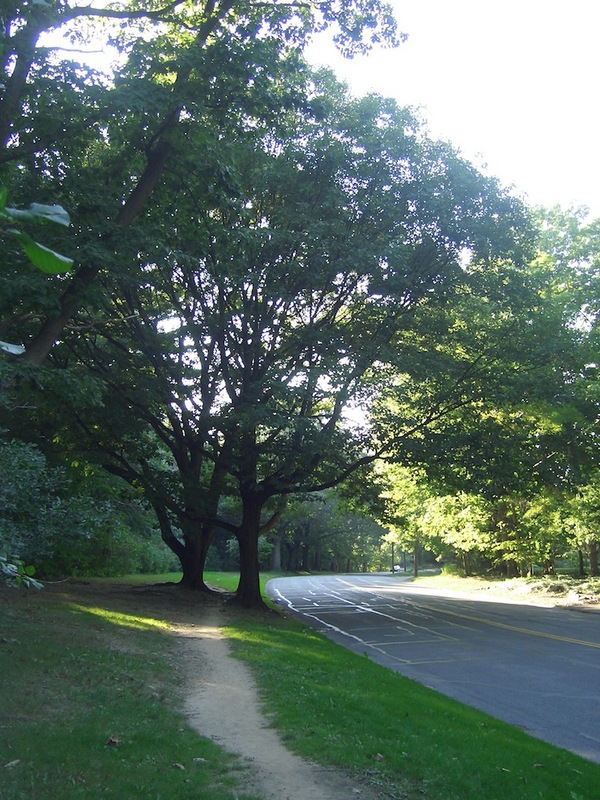

7. Which brings us back to the centaur and its characteristics.
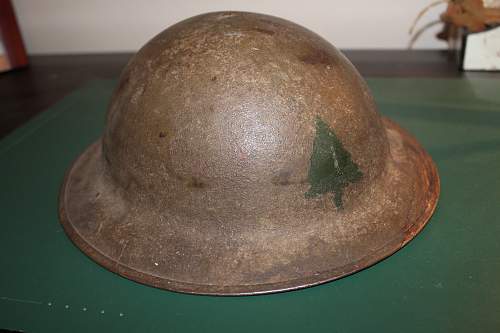
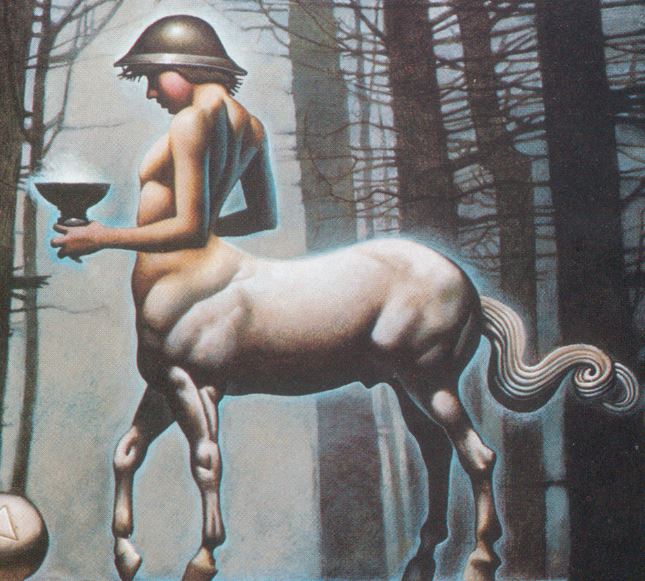
Centaurs are reported to be fierce in battle.
Are creatures of the forest, as depicted by the trees in the image.
One of their ancestral homes of lore is thought to be the Foloi Oak Forest.
(Oaks, like the ones planted on Liberty Row).
The helmet the centaur wears appears to be one very similar to any of several worn by the allies n World War I.
8. Following the path of Liberty Row up MLK Dr. we spot another marker at a Liberty Oak right in front a the Lithuanian Gardens. The next one up ahead is the Greek Cultural Gardens.
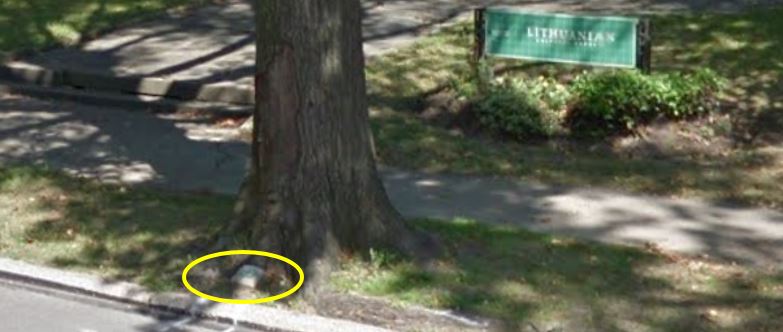
Which brings us to a stretch of Martin Luther King Dr. (formerly Liberty Blvd) in the Cultural Gardens where our verse begins:
A. Beneath two countries
The casque was buried in the Grecian Cultural Garden. "Beneath two countries" means when you are still on MLK Blvd., before you follow the curve in the road, you gaze up at the Greek and Italian Gardens high above you on the hillside.
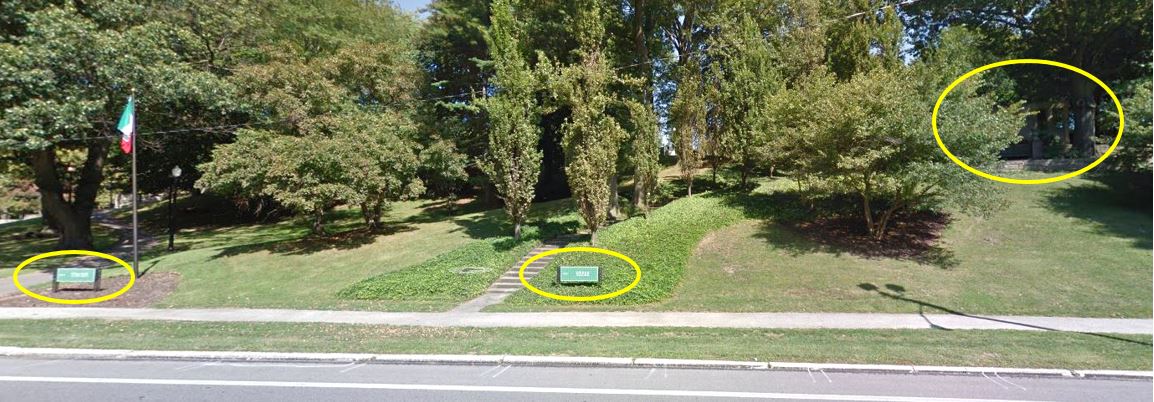
B. As the road curves
Parkgate Avenue curves around this section of the gardens. Which also may be hinted at in a section of the centaur's tail.
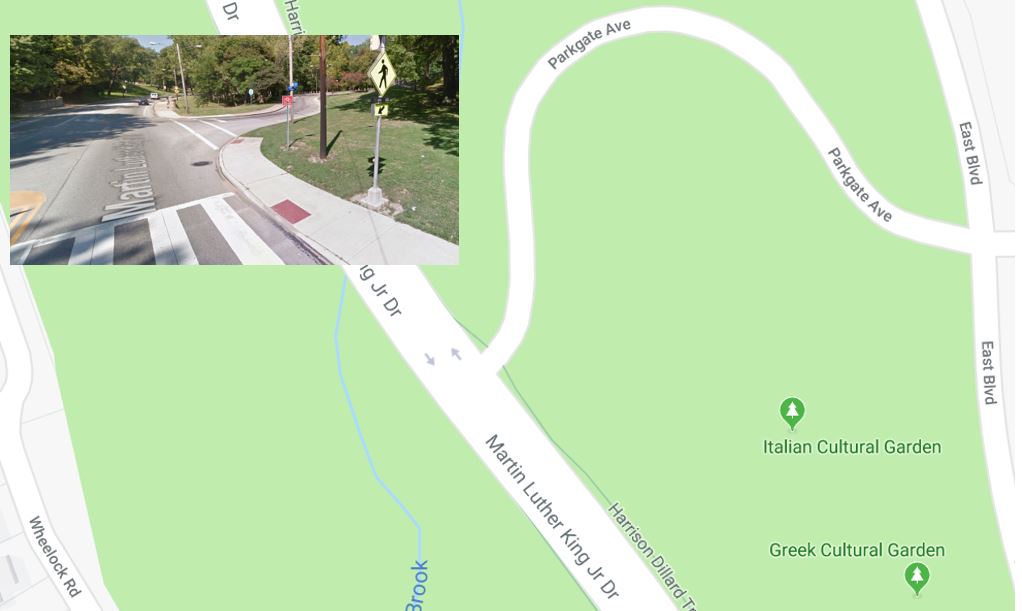
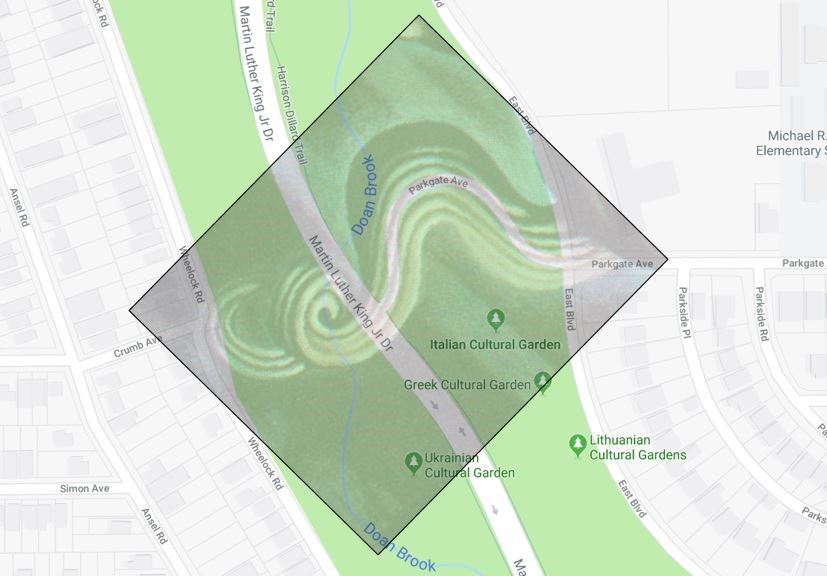
As we follow the bend in Parkgate Ave. we see confirmation that we're on the right course when we spot the back wall of the Italian Gardens and the images matches found there.
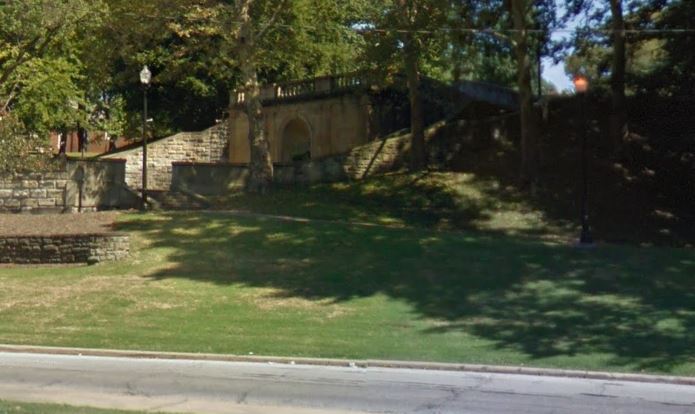

Coming the rest of the way around the Parkgate Ave. bend, we arrive at East Blvd. and the front of the Italian Gardens with the image matches found there.
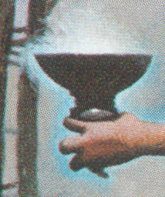

Skipping ahead to the end lines at this point we're supposed to notice 'the columns" we seek to our left at the Greek Gardens.

C. In a rectangular plot
D. Beneath the tenth stone
E. From right to left
F. Beneath the ninth row from the top
G. Of the wall including small bricks
H. Seven steps up you can hop
I. From the bottom level
These are explicit directions to the sunken planter and more importantly it contains very detailed and precise instructions to EXACT spot to dig up the casque. In the Expedition Unknown episode Andy Abrams explained that once the instructions were interpreted properly, he stuck the probe in twice and hit the casque on the third try.
However as the middle lines in the verse, they are clearly out of place and indicate that the verses in this puzzle is in non-linear order.
This is definitely an example of the of the 'backward/reverse or out of order hypothesis" holding true.
For further analysis on this, see the Solve Dissection section below.
Note: the placement of the sunken planter is NOT on the front of the wall from which we will later make our approach. It's on the back or reverse side of the wall.
J. Socrates, Pindar, Apelles
These names, among those of many other luminaries of ancient Greece, are chiseled into the Pylon Monument.
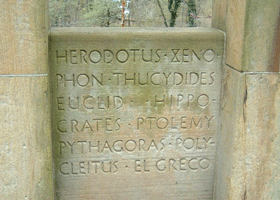
Yet this whole section of verse from this point forward again appear to be out of order. The final instructions to the dig spot are above and this section appears to hold the clues to how we are to arrive at that location.
Even within this section the lines appear to be backwards. It is not possible to read or even notice this inscription until well after finding 'the columns' we are supposed to be seeking.
Again, for more on the 'backwards/reverse or out of order hypothesis' see the Solve Dissection section below.
K. Free Speech, couplet, birch
Refers, respectively, to Socrates (died for free speech), Pindar (a poet), and Apelles (a painter; "birch brush").
L. To find casque's destination
M. Seek the columns
N. For the search.
The entrance to the Grecian Garden is marked by two columns that appear in Image 4.
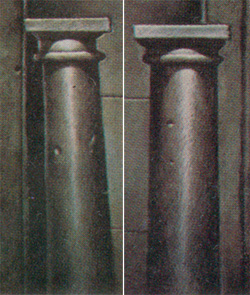
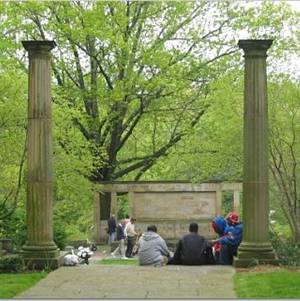
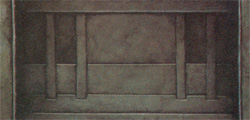
The columns are the key clue that leads us into the Greek Cultural Gardens and to the Pylon Monument.
In addition, the inscription with the names of the Greek luminaries is also on this front side of the monument.
So, this is clearly the way we are meant to make our approach.
Yet the planter and dig spot for which the instructions in verse lines 3-9 apply are on the reverse side of this wall. With no overt explanation or instruction to go around to the other side.
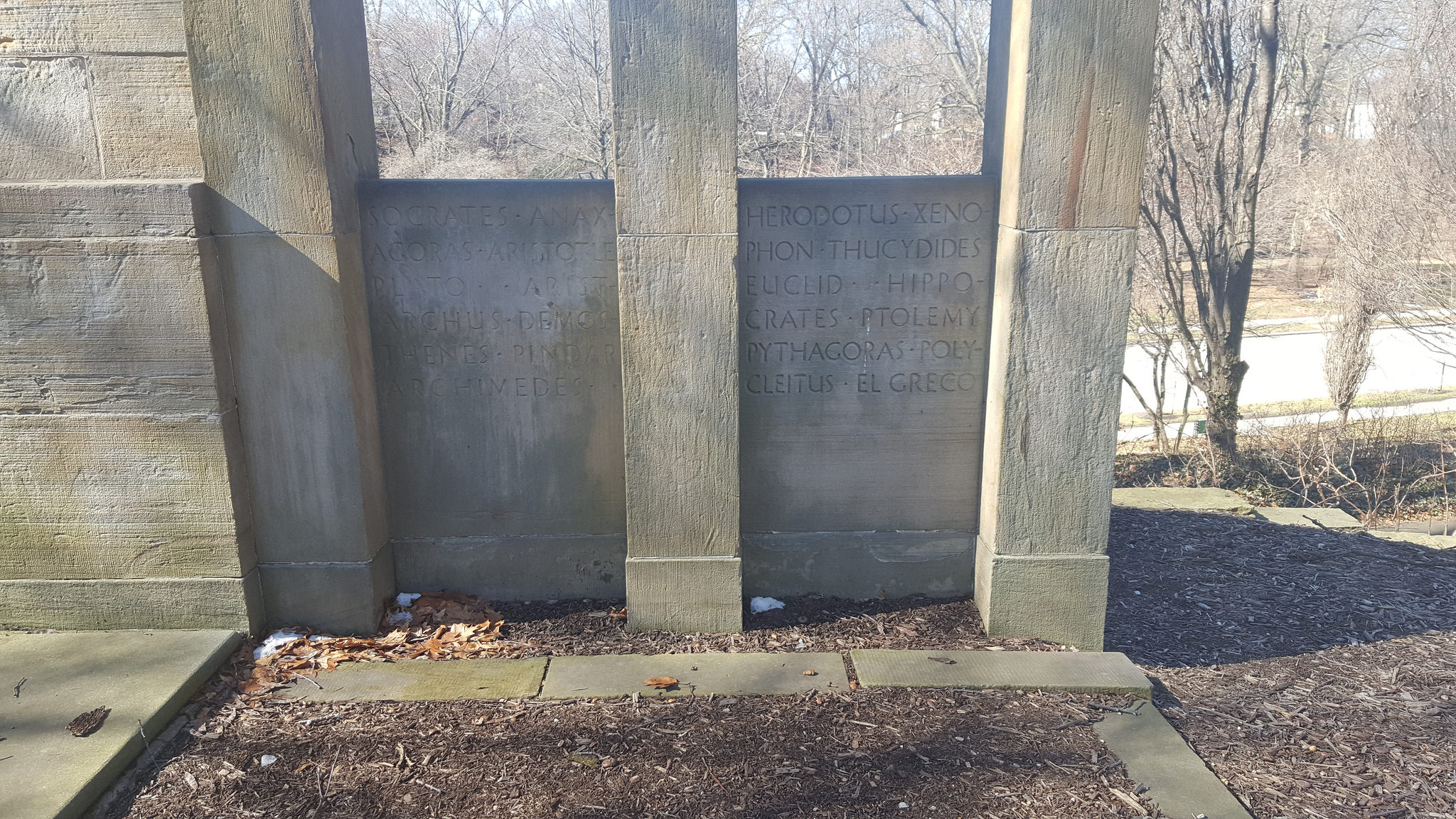
Final Location: 41.527651 N, 81.626926 W.
(Latitude: 41.527651, Longitude: 81.626926)
Painting 4 Verse 4 Solution
The solution given below will present clues from the verse and the image in a way that narrows down the search area to that specific point. Bits of the original image are shown in the left column in cells with a tan background. Lines from the verse are in the same column but with a yellow background. (For more detail about any particular clue, check the page for the image or verse.)
1. The shape to the left of the monument suggests that we should be looking in Ohio, possibly near a major highway.


2. As discussed above these icons hint at latitude and longitude, but only of some numbers are reversed or possibly also moved out or order.


Reversing the 14 could give us a bracket of 41 & 42. The 1881 is a question mark using this technique.
Reversing the 14 and introducing a decimal could give us 41.42.
Reversing the 18 AND moving it out of order could give us 81.81.
This would get us close to Cleveland but not near the park that we know is correct.
Cleveland is of course also confirmed by the Terminal Tower image match.
3. The sphere with the triangle on it shape is a reference to Euclid "The Father of Geometry." He was of course, also Greek.


Euclid Ave (Route 20) is a major Cleveland thoroughfare that runs from downtown through East Cleveland. It runs by the lower section of Rockefeller Park which is home to the Cultural Gardens.
That area also contains Bellflower Road and the last remnant of Liberty Blvd. (See below for more info)
4. The icon of the bell and flower in close proximity may hint at Bellflower Road. However reading of lines usually flows down.


To make a Bell+Flower rebus from these icons, this would need to be another example of something that is backwards or reversed in this puzzle.
Bellflower Road is shown here in its entirely. Its length is entirely within the campus of Case Western Reserve University. There are many buildings of higher learning nearby plus a hospital, performing arts center and Science and Art museums.
With many of the arts and sciences flowing from the Greek tradition, if Preiss intended Bellflower Road to be a clue in the puzzle, this would be a likely reason why.
5. Just south and west of Bellflower road and next to the university campus is the last remaining remnant of Liberty Boulevard.


In 1981 the rest of Liberty Blvd was renamed Martin Luther King Dr. That is the road that runs up through the park and through the Cultural Gardens.
Liberty Blvd was in turn a street that was renamed in 1919. It was so named on Memorial Day 1919 to commemorate Liberty Row.
Which is definitely the main reason for this "Liberty" (bell) icon and is the clue that bring us up from Euclid Ave into Rockefeller Park and toward the Cultural Gardens.
6. Liberty Row was the name given to what was then one of the first "living memorials."
By that Memorial Day celebration hundreds of "Liberty Oaks" were planted along a nine-mile string of several connected roads running next to and through a string of parks in this section of Cleveland. At the foot of each Liberty Oak was embedded a circular bronze marker with the name of a soldier killed in the recently concluded WWI.



7. Which brings us back to the centaur and its characteristics.


Centaurs are reported to be fierce in battle.
Are creatures of the forest, as depicted by the trees in the image.
One of their ancestral homes of lore is thought to be the Foloi Oak Forest.
(Oaks, like the ones planted on Liberty Row).
The helmet the centaur wears appears to be one very similar to any of several worn by the allies n World War I.
8. Following the path of Liberty Row up MLK Dr. we spot another marker at a Liberty Oak right in front a the Lithuanian Gardens. The next one up ahead is the Greek Cultural Gardens.

Which brings us to a stretch of Martin Luther King Dr. (formerly Liberty Blvd) in the Cultural Gardens where our verse begins:
A. Beneath two countries
The casque was buried in the Grecian Cultural Garden. "Beneath two countries" means when you are still on MLK Blvd., before you follow the curve in the road, you gaze up at the Greek and Italian Gardens high above you on the hillside.

B. As the road curves
Parkgate Avenue curves around this section of the gardens. Which also may be hinted at in a section of the centaur's tail.


As we follow the bend in Parkgate Ave. we see confirmation that we're on the right course when we spot the back wall of the Italian Gardens and the images matches found there.


Coming the rest of the way around the Parkgate Ave. bend, we arrive at East Blvd. and the front of the Italian Gardens with the image matches found there.


Skipping ahead to the end lines at this point we're supposed to notice 'the columns" we seek to our left at the Greek Gardens.

C. In a rectangular plot
D. Beneath the tenth stone
E. From right to left
F. Beneath the ninth row from the top
G. Of the wall including small bricks
H. Seven steps up you can hop
I. From the bottom level
These are explicit directions to the sunken planter and more importantly it contains very detailed and precise instructions to EXACT spot to dig up the casque. In the Expedition Unknown episode Andy Abrams explained that once the instructions were interpreted properly, he stuck the probe in twice and hit the casque on the third try.
However as the middle lines in the verse, they are clearly out of place and indicate that the verses in this puzzle is in non-linear order.
This is definitely an example of the of the 'backward/reverse or out of order hypothesis" holding true.
For further analysis on this, see the Solve Dissection section below.
Note: the placement of the sunken planter is NOT on the front of the wall from which we will later make our approach. It's on the back or reverse side of the wall.
J. Socrates, Pindar, Apelles
These names, among those of many other luminaries of ancient Greece, are chiseled into the Pylon Monument.

Yet this whole section of verse from this point forward again appear to be out of order. The final instructions to the dig spot are above and this section appears to hold the clues to how we are to arrive at that location.
Even within this section the lines appear to be backwards. It is not possible to read or even notice this inscription until well after finding 'the columns' we are supposed to be seeking.
Again, for more on the 'backwards/reverse or out of order hypothesis' see the Solve Dissection section below.
K. Free Speech, couplet, birch
Refers, respectively, to Socrates (died for free speech), Pindar (a poet), and Apelles (a painter; "birch brush").
L. To find casque's destination
M. Seek the columns
N. For the search.
The entrance to the Grecian Garden is marked by two columns that appear in Image 4.



The columns are the key clue that leads us into the Greek Cultural Gardens and to the Pylon Monument.
In addition, the inscription with the names of the Greek luminaries is also on this front side of the monument.
So, this is clearly the way we are meant to make our approach.
Yet the planter and dig spot for which the instructions in verse lines 3-9 apply are on the reverse side of this wall. With no overt explanation or instruction to go around to the other side.

Final Location: 41.527651 N, 81.626926 W.
(Latitude: 41.527651, Longitude: 81.626926)
Part 4
If you read through everything so far, thanks for indulging. Please feel free to reply with any comments or observations on where you might think the remaining treasures are or any other opinion. This has grabbed my interest to the point where I may try to find some of the treasures myself.
Here are some online resources where I gathered information for this thread. There are also hundreds of theories and discussions to be found here.
Quest4Treasure (Q4T)
Something Awful
Tweleve
White Rabbit's Solutions
Looking forward to comments. Happing hunting!
If you read through everything so far, thanks for indulging. Please feel free to reply with any comments or observations on where you might think the remaining treasures are or any other opinion. This has grabbed my interest to the point where I may try to find some of the treasures myself.
Here are some online resources where I gathered information for this thread. There are also hundreds of theories and discussions to be found here.
Quest4Treasure (Q4T)
Something Awful
Tweleve
White Rabbit's Solutions
Looking forward to comments. Happing hunting!
a reply to: jtrenthacker
Interesting thread, deserves S & F just for the effort alone.
Treasure hunt in your backyard
Why do you Americans have all the fun?
Interesting thread, deserves S & F just for the effort alone.
Treasure hunt in your backyard
Why do you Americans have all the fun?
Wow! fascinating. I've never heard of such a thing before....and the artwork is fabulous too just up my street
I'd love to be clever enough to do something like this but alas old age and senility creeping in
I'd love to be clever enough to do something like this but alas old age and senility creeping in
a reply to: jtrenthacker
Ok, I'm getting a little excited here. I looked online to see what people have found already, and I know where they are getting jammed up. Either I'm delusional, or I really think I know where this is. By the way, I don't think most people would be able to find a lot of these on today's information. A very key piece of the puzzle on Milwaukee's one is a something that isn't there anymore! I'm not originally from this area but have lived here long enough to know all the names of these key places. I think people that lived here forever are being blinded by their bias.
My son and I are going to go check it out during warmer weather!
BTW. if it is where I think it is this guy has a sense of humor
Ok, I'm getting a little excited here. I looked online to see what people have found already, and I know where they are getting jammed up. Either I'm delusional, or I really think I know where this is. By the way, I don't think most people would be able to find a lot of these on today's information. A very key piece of the puzzle on Milwaukee's one is a something that isn't there anymore! I'm not originally from this area but have lived here long enough to know all the names of these key places. I think people that lived here forever are being blinded by their bias.
My son and I are going to go check it out during warmer weather!
BTW. if it is where I think it is this guy has a sense of humor
edit on 4-4-2019 by JAGStorm because: (no reason given)
originally posted by: JAGStorm
a reply to: jtrenthacker
Ok, I'm getting a little excited here. I looked online to see what people have found already and I know where they are getting jammed up. Either I'm delusional or I really think I know where this is. By the way, I don't think most people would be able to find a lot of these on today's information. A very key piece of the puzzle on Milwaukee's one is a something that isn't there anymore! I'm not originally from this area but have lived here long enough to know all the names of these key places. I think people that lived here forever are being blinded by their bias.
My son and I are going to go check it out during warmer weather!
BTW. if it is where I think it is this guy has a sense of humor
Awesome! Report back to us your findings!
a reply to: jtrenthacker
From your link.
This is the best clue and where everyone is getting messed up.
If I am right, people are reading way way way too much into a their own minds distorted messages, when I think the author maybe made it too easy, you know hidden in plain sight! Like when you can't find your glasses because you are wearing them!
From your link.
This is the best clue and where everyone is getting messed up.
6. The picture is the key to it all. In both of the found treasures, the evidence pointing to the location was almost entirely in the picture. To stay on the right path, you should not even look at the poems until there is substantial evidence from the picture relating a few landmarks or objects.
If I am right, people are reading way way way too much into a their own minds distorted messages, when I think the author maybe made it too easy, you know hidden in plain sight! Like when you can't find your glasses because you are wearing them!
9. Check reality. The author wasn’t some sort of brilliant puzzle making genius who wanted to make the most radically difficult and clever puzzles in the universe. In one of his poems he said “L sits and left beyond his shoulder” and L was used to refer to Lincoln. That’s not clever; it’s really sort of lazy. And remember he also didn’t have Google satellite imagery and an absolute knowledge of the history of every city he visited.
a reply to: jtrenthacker
They found a bunch of 'em, tv show on it a few months ago.
There's a ton on Youtube about it.
They found a bunch of 'em, tv show on it a few months ago.
There's a ton on Youtube about it.
a reply to: jtrenthacker
I watched an episode of one of Josh Gates shows about this! I was surprised that there are still many people actively searching for these treasure boxes!
It's a shame that they haven't all been found yet. Natural landmarks change or sometimes are completely removed, even man made landmarks sometimes are moved or even destroyed. Knowledge of what some of the clues mean has been lost. I'm afraid some or most of them may never be found.
I watched an episode of one of Josh Gates shows about this! I was surprised that there are still many people actively searching for these treasure boxes!
It's a shame that they haven't all been found yet. Natural landmarks change or sometimes are completely removed, even man made landmarks sometimes are moved or even destroyed. Knowledge of what some of the clues mean has been lost. I'm afraid some or most of them may never be found.
originally posted by: DBCowboy
a reply to: jtrenthacker
They found a bunch of 'em, tv show on it a few months ago.
There's a ton on Youtube about it.
Only two have been officially found. Of course there is always a chance some have been found and never made public. I doubt it though.
edit on
4-4-2019 by jtrenthacker because: (no reason given)
a reply to: jtrenthacker
History or Travel channel has a show on this w Josh Gates following clues, how they are placed into the paintings...even finding one himself.
You can find it easily by searching YouTube or the apps for History and Travel channels...
History or Travel channel has a show on this w Josh Gates following clues, how they are placed into the paintings...even finding one himself.
You can find it easily by searching YouTube or the apps for History and Travel channels...
a reply to: mysterioustranger
I just watched it on the Travel Channel app. Josh interviews the two groups who found the two casks. Josh did not find a cask although the show built it up that way. What they thought was plexiglass was some chunk of glass or rock. I believe that was in St. Augustine. Nonetheless, very cool episode.
I just watched it on the Travel Channel app. Josh interviews the two groups who found the two casks. Josh did not find a cask although the show built it up that way. What they thought was plexiglass was some chunk of glass or rock. I believe that was in St. Augustine. Nonetheless, very cool episode.
Interesting to be sure.
S&F for the effort to the OP.
I guess my initial reaction is...some people have way, WAY, too much time on their hands! (not the OP)
Oh, and I loved this quote from the OP...
In other words...don't be coming over and digging up MY yard!! LOL!
S&F for the effort to the OP.
I guess my initial reaction is...some people have way, WAY, too much time on their hands! (not the OP)
Oh, and I loved this quote from the OP...
(d) any property owned by the contributors to the book, their families or friends."
In other words...don't be coming over and digging up MY yard!! LOL!
Expedition Unknown showed they have found Boston. It was in a park that was being torn up for renovation and the guy who found it had to tell the work
crew what was up and when they were digging they came across part of the clock and some plexiglass. They then let the show in and it was found
although broken.
The artist of the painting was also on and he showed some clues that everyone missed, like the angel's hair is shaped like a baseball diamond - it was found under home plate - and the word Boston is in there also. Pretty clever stuff.
Bummer one wasn't buried here. I might have had some luck but anywhere else I'm just not qualified.
Boston Globe
The artist of the painting was also on and he showed some clues that everyone missed, like the angel's hair is shaped like a baseball diamond - it was found under home plate - and the word Boston is in there also. Pretty clever stuff.
Bummer one wasn't buried here. I might have had some luck but anywhere else I'm just not qualified.
Boston Globe
edit on 11/10/2019 by TheSpanishArcher because: (no reason given)
new topics
-
Swedish Minister for Gender Equality is Seeking Treatment for Phobia of Bananas
Other Current Events: 6 hours ago -
Satanic ‘Little Season’ of Deception.. Awaken to the Handiwork of the Creator.
ATS Skunk Works: 6 hours ago -
USA-BIDEN and CHINA-Xi Agree Not To Let Artificial Intelligence Decide Nuclear Weapons Use.
World War Three: 6 hours ago -
The mysterious death of Aileen Conway
General Chit Chat: 9 hours ago
top topics
-
Does the Trump win mean No More Taylor Swift??
Politicians & People: 17 hours ago, 12 flags -
The mysterious death of Aileen Conway
General Chit Chat: 9 hours ago, 6 flags -
USA-BIDEN and CHINA-Xi Agree Not To Let Artificial Intelligence Decide Nuclear Weapons Use.
World War Three: 6 hours ago, 3 flags -
Satanic ‘Little Season’ of Deception.. Awaken to the Handiwork of the Creator.
ATS Skunk Works: 6 hours ago, 3 flags -
Swedish Minister for Gender Equality is Seeking Treatment for Phobia of Bananas
Other Current Events: 6 hours ago, 3 flags -
Half-Life 2 is 20 Years Old - its Also Free on Steam until the 18th
Video Games: 14 hours ago, 1 flags
active topics
-
President-elect TRUMP Picks MATT GAETZ for his ATTORNEY GENERAL - High Level PANIC Ensues.
2024 Elections • 93 • : EyeoftheHurricane -
I’m Looking for Information on the Light We See at Death.
The Gray Area • 62 • : whereislogic -
On Nov. 5th 2024 - AMERICANS Prevented the Complete Destruction of America from Within.
2024 Elections • 157 • : WeMustCare -
Candidate TRUMP at MADISON SQUARE GARDEN - Sold Out in Just 3 Hours - Sun Oct 27th 2024.
2024 Elections • 51 • : WeMustCare -
Does the Trump win mean No More Taylor Swift??
Politicians & People • 50 • : bluesman023 -
The Trump effect 6 days after 2024 election
2024 Elections • 150 • : cherokeetroy -
TODAY IS A HUGE ELECTION DAY FOR AMERICA - November 5th 2024 - Reports from Around The Nation.
2024 Elections • 750 • : WeMustCare -
President-Elect DONALD TRUMP's 2nd-Term Administration Takes Shape.
Political Ideology • 213 • : WeMustCare -
Satanic ‘Little Season’ of Deception.. Awaken to the Handiwork of the Creator.
ATS Skunk Works • 4 • : NorthOS -
-@TH3WH17ERABB17- -Q- ---TIME TO SHOW THE WORLD--- -Part- --44--
Dissecting Disinformation • 3284 • : 777Vader
23
